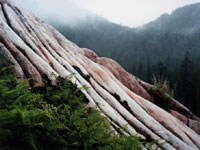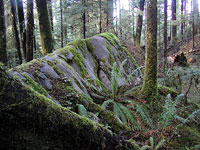Applying karst best management practices to harvesting operations (lesson 5)
On this page
Learning objectives
This lesson describes how to apply karst best management practices to harvesting operations. By working through this lesson you will understand that:
- Different best management practices are recommended for different levels of karst vulnerability
- As the level of karst vulnerability increases, so do the protective measures of the recommended best management practices
Introduction
In Lesson 2 you were introduced to the karst inventory process and vulnerability assessments. In this lesson you will learn how to apply specific best management practices to karst areas with different vulnerability ratings.
Below: Karst feature in a harvest area - click to enlarge
Vulnerability ratings
Do you remember the four categories of karst vulnerability from Lesson 2?
- Low
- Moderate
- High
- Very High
Are there any vulnerability categories where timber harvesting is not recommended?
Karst areas classified as very high vulnerability contain sensitive, high resource values. In most cases, it is recommended that very high vulnerability areas be excluded from harvesting operations. Limited exceptions to this may occur in special situations where some form of site-specific intervention is required to help protect forest or karst resources (e.g., forest health issues such as insect infestations). Any forest management activities that may be required on very high vulnerability karst areas should be conducted in consultation with a karst specialist, the Forest Service, and/or other relevant resource agencies.
On which vulnerability categories are harvesting operations recommended?
Harvesting operations will generally occur on low, moderate, and high vulnerability karst areas. As the level of karst vulnerability increases, so do the protective measures of the recommended best management practices.
How are the recommended best management practices linked to the assessed vulnerability of the karst?
Below: Recommended best management practices are linked to the assessed vulnerability of the karst area - click to enlarge and see explanations.
Self check questions
Answer either True or False to check your understanding.
- Harvesting is recommended on very high vulnerability areas
- Best management practices for high vulnerability areas include recommendations for both low and moderate vulnerability areas
Self Check Answers
- False
- True



